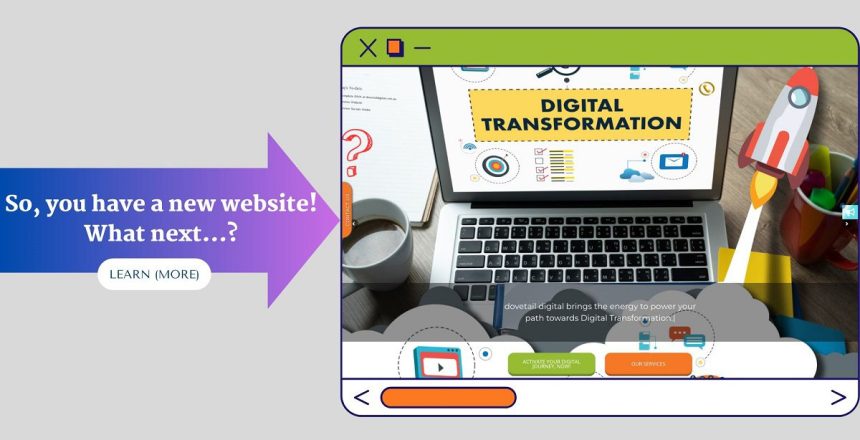A website has become an essential tool for growth, competitiveness, and success in the modern digital landscape and ensuring your website is clearly articulating what your business does is critical to your business engaging and encouraging the right type of decision-maker. Don’t think your website is important. Think again!
So, have you ever really thought about the purpose of your business website? Is its primary focus to sell or be more informational? Perhaps it’s a mix of both..? Have you recently been involved in building or updating a website, or have you had a website in place for ages, with no updates or changes and perhaps wondering if it is having an impact on your business?
We know…it’s not easy! But designing & building a website is only the beginning. Job done? We don’t think so…
Here’s the thing, no website is ever, “done”. On the contrary, it’s an ever-evolving digital door into your business. Maximising its potential is where the real work starts to help it achieve its Return on Investment (ROI).
Before you get started or even look to partner with someone to update, refresh or build a website you need to give some genuine thought to the purpose of your website. This important first step can be quite a cathartic step and provides the opportunity to review your business and what may make it different from your competitors.

Here are some other key statistics to consider before getting started:
- Seems like a long time and in some cases it’s even longer. These days buyers have the opportunity to take their time to invest their money, wisely.
- Every industry will differ based on what they are selling and you can expect this average to rise (1.5-2%) or fall (0.5-1%) depending on the complexity or value associated with the product or service. Either way, this is a critical statistic for your business and the performance of your website. We speak to many businesses about this and it’s become increasingly obvious that a lot of businesses don’t really know how well their website is performing for their business.
It doesn’t matter how small, mid-size, or big your business is, the following 4 key areas are often forgotten in relation to a great-performing website journey: being connected, updates and maintenance, user experience, and developing a consistent content strategy. So, let’s jump in and ensure your website remains a powerful tool for your business’s success.
1. Connect Your Website
I mentioned earlier that your website is the digital door into your business. It’s available 24 hours a day, 7 days per week and is available to everyone, everywhere and that, in essence, is the forgotten opportunity. Your website needs to be connected to modern systems such as Customer Relationship Management (CRM) tools (e.g. Constant Contact) or Email Service Provider (ESP) tools (e.g. MailChimp).
In their simplest form, these modern tools help bring your leads, prospects, and customers into focus and are the backbone of maintaining and building your database with online activity-based automation (e.g. web visitor completes a form to download information about your business and is added to your database) and insightful data you can repurpose for future business plans. It also helps enhance the Customer Experience with timely information. They also help monitor and measure the effectiveness of your website providing a better understanding of whether known or unknown leads are likely to become customers.
2. Updates and Maintenance
Once your website is live, it requires ongoing attention and care. Regular updates and maintenance are vital to keep your website running smoothly and provide a positive user experience. Here are some essential tasks to consider:
- Keep Your Content, Fresh! – You may not see it but web visitors appreciate fresh and relevant content. Regularly updating your website with new blog posts, articles, or product information builds trust and confidence in your business. This also keeps visitors engaged and improves your search engine rankings (SEO).
- Link and Functionality Checks – Regularly review all links on your website to ensure they are functioning correctly. Broken links frustrate visitors and negatively impact your website’s credibility. Additionally, perform regular checks on all functionalities such as contact forms, shopping carts, and search features to ensure they are working seamlessly.
- Technical Issues: Stay vigilant in monitoring your website for any technical issues. This includes checking for browser compatibility, fixing any error messages, and optimising page loading times. Addressing these issues promptly ensures a smooth user experience and prevents potential revenue loss.
Enhancing the user experience is key to keeping visitors engaged and encouraging them to explore your website further. Here are some areas to focus on:
- Navigation: Review your website’s navigation structure to ensure it is intuitive and user-friendly. Simplify menus, use clear and concise labels, and make it easy for visitors to find what they are looking for.
- Page Load Times: Slow-loading pages frustrate users and increase bounce rates. Optimize your website’s performance by compressing images, minimizing code, and utilizing caching techniques. This will enhance the overall user experience and improve search engine rankings.
- Design and Usability: Assess the design elements of your website, including colors, fonts, and layouts. Aim for a clean and visually appealing design that aligns with your brand identity. Make sure buttons and links are easy to identify, and forms are straightforward to fill out. Prioritise mobile responsiveness to cater to the increasing number of users accessing websites on their smartphones.
A well-defined content strategy is vital for engaging your target audience and achieving your business goals. Consider the following aspects:
- Goals and Target Audience: Clearly define your website’s goals, whether it’s generating leads, driving sales, or providing valuable information. Understand your target audience’s needs, preferences, and pain points to tailor your content accordingly.
- High-Quality and Relevant Content: Create content that offers value to your visitors. Craft compelling blog posts, informative articles, and engaging videos. Incorporate relevant keywords to improve search engine visibility, but prioritize creating content that educates, entertains, or solves problems for your audience.
- Call-to-Action (CTA): Encourage visitors to take specific actions through strategically placed CTAs. Whether it’s signing up for a newsletter, making a purchase, or contacting you for more information, CTAs guide visitors toward the desired conversion points.

Although there are many other areas to consider (e.g. SEO, Conversion Optimisation, Mobile Optimisation, Analytics & Tracking) we feel this is a good place to start. Just remember, a website’s success in the eyes of the business goes beyond its initial creation or its next refresh. Ensuring it is connected 24/7, updated and maintained regularly ensures it remains fresh and functional, while user experience enhancements drive better prospect and customer engagement and satisfaction. A well-executed content strategy with high-quality and relevant content will keep visitors coming back leading to an increase in conversion rate performance.
At dovetail digital, we can help produce a website you will love and one that will perform the way you want…but before getting started, don’t just ask yourself if you need a new or refreshed website (the answer is of course yes), instead ask yourself, what is it you want it to achieve?
Let's start a Conversation!
dovetail digital brings the energy required to help small to medium-sized businesses overcome their daily challenges and ultimately, compete better. Our mission is to support your journey to digital maturity with the right tools and expertise. With a solution-driven approach and unbiased mindset, we solve problems that deliver better outcomes.


